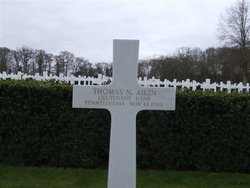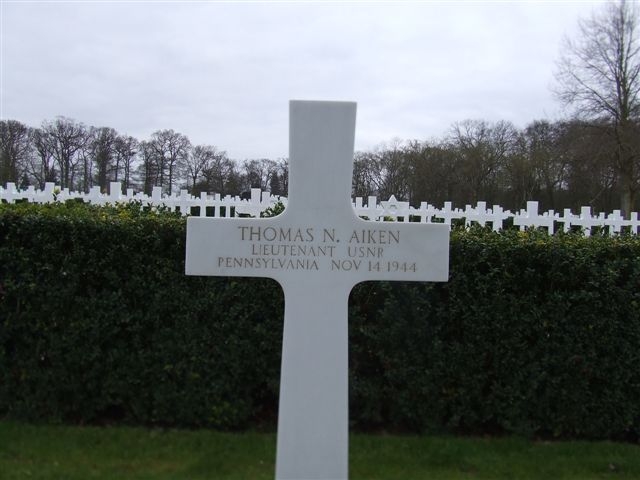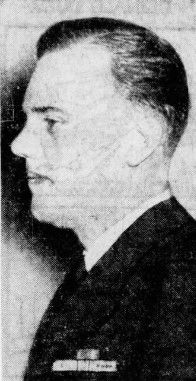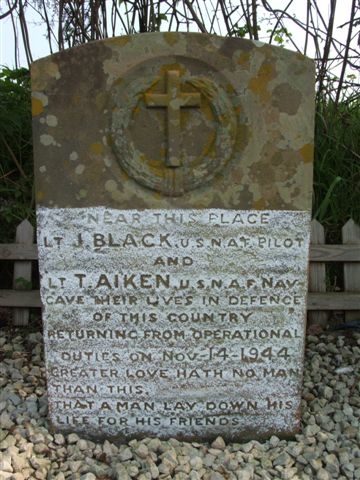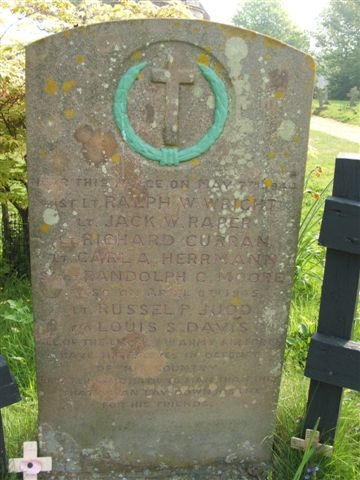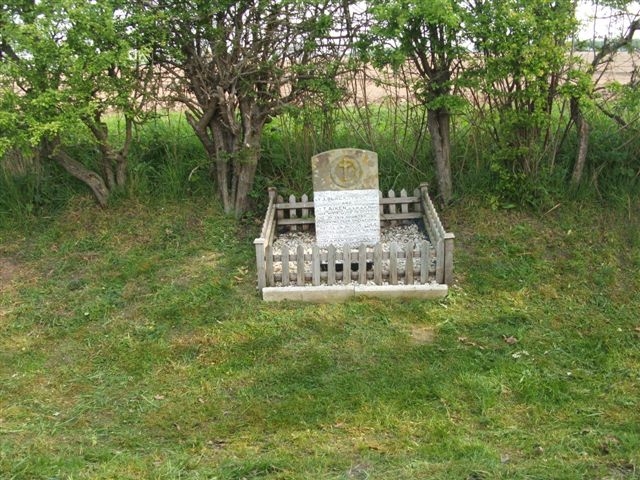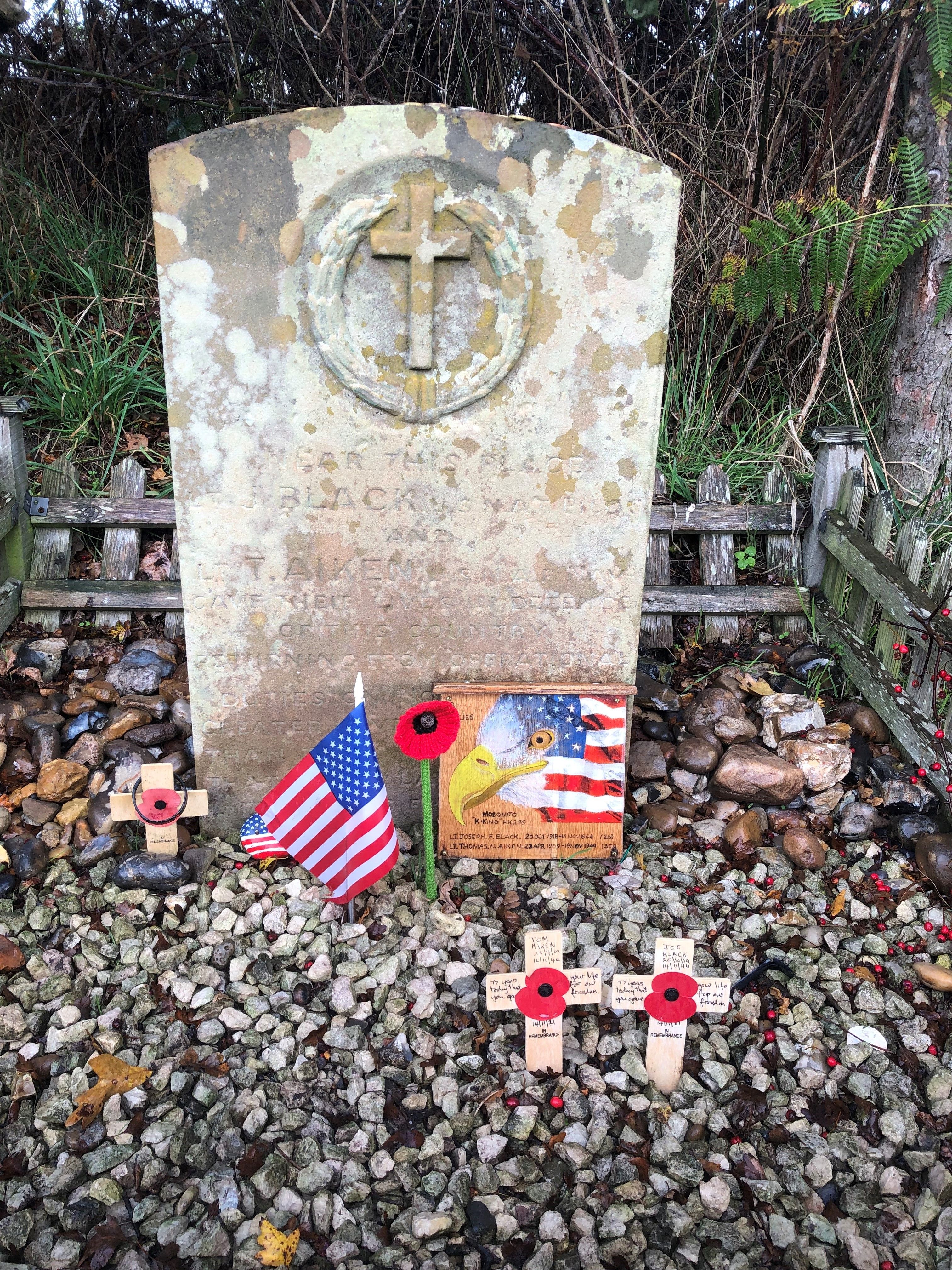By autumn 1944 the allied forces in Western Europe had destroyed all the launch areas for the German V1 flying bombs. The Luftwaffe then began a programme of air-borne launching of the missiles. Thomas entered the service from Pennsylvania.Tom had been educated near his home at the Museum School of Industrial Art. He enlisted as an air gunner on 3rd February 1941 until March 31st 1943 when he became a junior grade Lieutenant. He fought the Japanese from the aircraft carrier, USS Essex and his service won him the Air Medal, the Gold Star in place of a second Air Medal, and the Purple Heart. In early 1944 he was selected for night-fighter training with the RAF by which time he had been promoted to full Lieutenant.
Thomas and Joe were part of a ten man group of US Navy airmen who gathered together on 1st July 1944 at USN Forces HQ in London for training and eventual transfer to the Pacific theatre to combat Japanese night-fighters. Only four of this group were to survive the war.From London, the group transferred to No.51 Operational Training Unit at RAF Cranfield in Bedfordshire.At the time of his death, the squadron had only recently moved to RAF Coltishall, Norfolk.The Mosquito was described as Britain's "Wooden Wonder"-it featured two Rolls-Royce Merlin engines and was constructed of plywood and balsa wood.His Mosquito was named/numbered "K-King, HK 289.
A memorial to them, erected by Lord and Lady Somerleyton, is in Waddling Lane, Somerleyton, Suffolk,(it stands almost in the hedgerow on Home Farm beside the Flixton bridleway) inscribed as follows:
NEAR THIS PLACE
LT J.BLACK U.S. N.A.F. PILOT
AND
LT T. AIKEN U.S. N.A.F. NAV
GAVE THEIR LIVES IN DEFENCE
OF THIS COUNTRY
RETURNING FROM OPERATIONAL
DUTIES ON NOV 14 1944
GREATER LOVE HATH NO MAN
THAN THIS.
THAT A MAN LAY DOWN HIS
LIFE FOR HIS FRIENDS.
(Somerleyton memorial photos kindly provided by Graham & Margaret Gooch)
(note: some material sourced from "Final Flights" by Ian McLachlan)
By autumn 1944 the allied forces in Western Europe had destroyed all the launch areas for the German V1 flying bombs. The Luftwaffe then began a programme of air-borne launching of the missiles. Thomas entered the service from Pennsylvania.Tom had been educated near his home at the Museum School of Industrial Art. He enlisted as an air gunner on 3rd February 1941 until March 31st 1943 when he became a junior grade Lieutenant. He fought the Japanese from the aircraft carrier, USS Essex and his service won him the Air Medal, the Gold Star in place of a second Air Medal, and the Purple Heart. In early 1944 he was selected for night-fighter training with the RAF by which time he had been promoted to full Lieutenant.
Thomas and Joe were part of a ten man group of US Navy airmen who gathered together on 1st July 1944 at USN Forces HQ in London for training and eventual transfer to the Pacific theatre to combat Japanese night-fighters. Only four of this group were to survive the war.From London, the group transferred to No.51 Operational Training Unit at RAF Cranfield in Bedfordshire.At the time of his death, the squadron had only recently moved to RAF Coltishall, Norfolk.The Mosquito was described as Britain's "Wooden Wonder"-it featured two Rolls-Royce Merlin engines and was constructed of plywood and balsa wood.His Mosquito was named/numbered "K-King, HK 289.
A memorial to them, erected by Lord and Lady Somerleyton, is in Waddling Lane, Somerleyton, Suffolk,(it stands almost in the hedgerow on Home Farm beside the Flixton bridleway) inscribed as follows:
NEAR THIS PLACE
LT J.BLACK U.S. N.A.F. PILOT
AND
LT T. AIKEN U.S. N.A.F. NAV
GAVE THEIR LIVES IN DEFENCE
OF THIS COUNTRY
RETURNING FROM OPERATIONAL
DUTIES ON NOV 14 1944
GREATER LOVE HATH NO MAN
THAN THIS.
THAT A MAN LAY DOWN HIS
LIFE FOR HIS FRIENDS.
(Somerleyton memorial photos kindly provided by Graham & Margaret Gooch)
(note: some material sourced from "Final Flights" by Ian McLachlan)
Family Members
Sponsored by Ancestry
Advertisement
Advertisement
